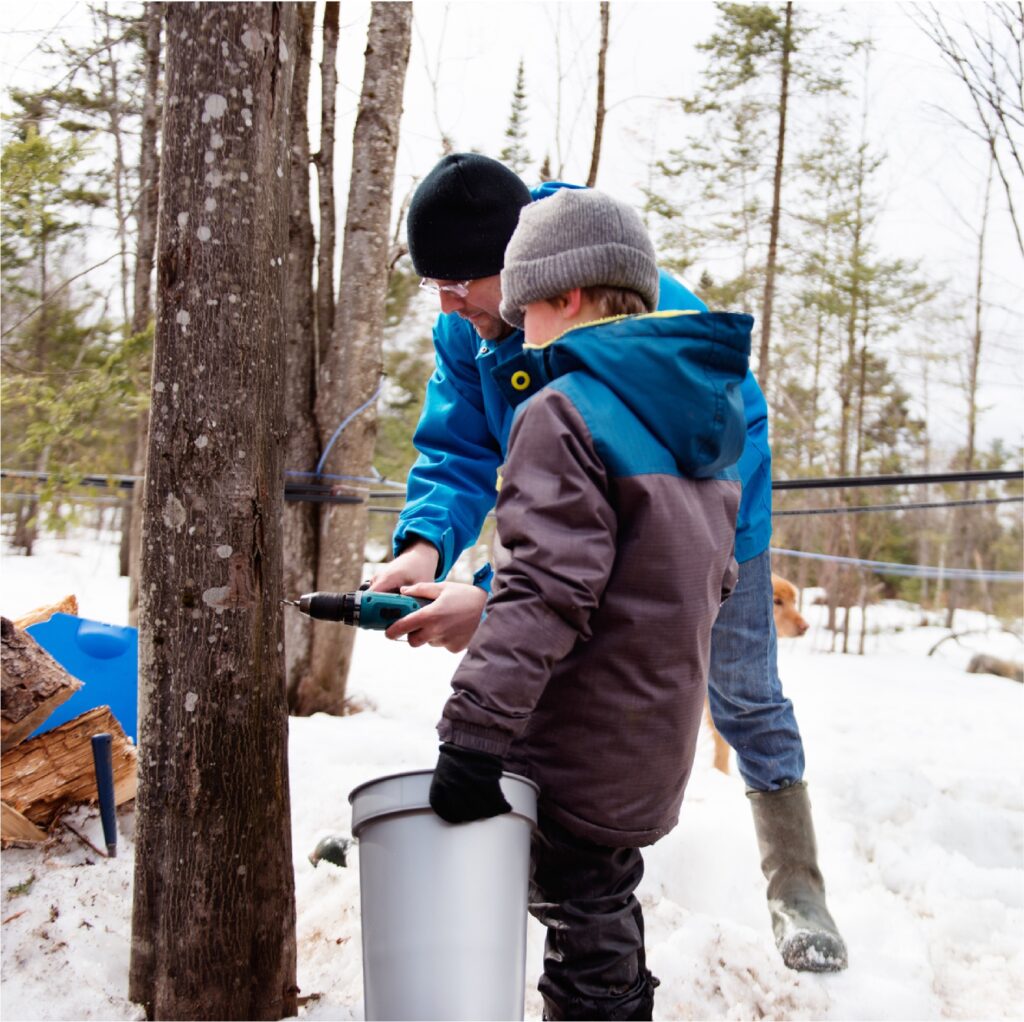
Maple Syrup Tapping – Multi Faceted Fun
If you have maple trees on your property, you could be pouring home-grown maple syrup on your pancakes next spring.
By Denise Thornton
The maple syrup production process is flexible enough to include people working in their own kitchens for the benefit of family and friends to those who want to add a significant income source from their woods.
Regardless of the scale you are interested in, the best place to start is identifying maple trees on your land, or on land you have permission to access from a neighbor, including public lands in some cases. County, state and federal lands all have different regulations, but many allow maple syrup production. Sugar maples are the most commonly tapped, but black maples are similar in terms of sap production. Red and silver maples can also be tapped to make syrup, according to Tony Johnson, Natural Resources Educator and Maple Syrup Project Manager at the University of Wisconsin-Madison Division of Extension.
Johnson advises finding trees at least 10 inches in diameter. He suggests that you can ask your county forester to walk your property with you to help identify the tree species in your woods. You can find your county forester here.

The second consideration is whether you have the time in the spring when the sap is flowing. Ideal conditions here in the Midwest are when the woods are starting to thaw out but before the buds of the tree begin to break. “The swings between freezing temperatures at night to thawing temperatures during the day create a pressure differential inside the trees,” Johnson says. “You only have a small window of about three weeks because once the maples start to bud out, the sugars in the tree start metabolizing to produce the new tissue, and the flavor of the sap changes.”
During that short period, there is a lot to do. “You need your storage and cooking equipment ready to go, and you will be emptying buckets every day. You may need snowshoes to get in and out of your woods, and sap is heavy — a little under ten pounds per gallon,” says Johnson. “Cooking the sap down to a syrup can take many hours, even if you are working on a small scale. You don’t necessarily have to stir, but you must continue adding sap and watching to make sure that it doesn’t boil over. It’s a good idea to enlist some family members or neighbors willing to help.”
Based on a survey of 700 producers about their motivation for engaging in maple syrup production, Johnson learned that the driving force for both commercial and small-scale producers is spending time in nature. It’s a beautiful time of year to be in the woods as everything is coming back to life.

The other aspect syrup producers value is spending time with family. “It can be an inter-generational activity where shared experiences are passed down from grandparents to parents to children. It’s a great opportunity to bring families together.”
If you are contemplating selling your syrup you need to inform yourself about what regulations you need to comply with as a food producer. There is a tool that will help you find the regulations that apply to you at this website.
Zooming out from the family bonding over the syrup pan, there is the big picture of a national syrup production community you will be joining. The leading maple producing states are Vermont, New York and Maine, and their industry is several decades ahead of Wisconsin. “The cutover of Wisconsin’s northern hardwood forests in the early 1900s really set back a lot of acreage that was historically tapped for maple syrup production by tribal nations,” says Johnson. There are records from the nineteenth century of tribes in the Upper Peninsula bringing hundreds of thousands of pounds of maple sugar to market.”
Wisconsin now has a lot of mature maples 80 to 100 years old that are ready to be tapped. According to the University of Vermont, which has a strong maple business program, there is a growing demand for maple syrup. “Wisconsin has about 3.7 million acres of maple forests, and currently only about half of a percent of those trees are being used for maple syrup production, so I think Wisconsin has a lot of room to grow the business,” says Johnson.
“We are hoping Wisconsinites will produce their own sweetener from trees that can be safely tapped many times in an intact forest. It’s a sustainable process that also provides ecological benefits to wildlife and people.” Johnson says. “This is a superior sweetener with a lot more nutrients than other common, less sustainably produced sweeteners.”
There are many resources available to help you get started. Check out the Maple Hour, a webinar series for Wisconsin Maple enthusiasts. Topics include Preparing for the 2024 Maple Season on December 7, Maple Tapping – Best Practices on February 15, and Invasive Plants in the Sugarbush on March 13. Register at this link.
New methods for producing syrup are increasing its efficiency, including reverse osmosis, which is a way of pulling water out of sap while cutting down on boiling time and fuel usage. A filter system is now being used that can separate and concentrate the sap that can dramatically reduce cooking time.
Johnson notes, “We also found out from our survey that most Wisconsin syrup producers rely on the equipment producers for technical information and outreach.”
The largest manufacturer of premium maple syrup equipment in the U.S. Is Smoky Lake Maple Products in Hilbert, Wisconsin. The company was established by Jim and Angela Schumacher about ten years ago. Though Angela notes that you can start making syrup with equipment you have at home, they can support every level of commercial production. “We can help you through the process from tapping to boiling to filtering and bottling, and we have all kinds of tutorials on our website.
Asked when to start, Angela says “There is no time like the present. The closer we get to the season, the busier we are going to get.” She concluded with advice for beginners, “You can start out tapping one or two trees. Even if you’re not sure you want to do the whole process — just tap a tree and collect some sap. Then take that sap, which is a lot like water, and make some tea with it or add it to soup. You can experience something tasty and free that comes right from your land.”

Syrup grading sidebar
Many people in the know have always chosen Grade B maple syrup, understanding that it was more flavorful than Grade A, but in the past few years, it is no longer possible to find Grade B. That’s because the old A-B grading system was considered by the industry to be confusing, and it has been replaced.
Sap from the same tree can produce different grades throughout the season. “You could start collecting sap that is graded golden and end up with a darker syrup,” says Johnson. “Part of it is about the internal sugars in the tree, and part is tapping and processing hygiene. Impurities can lead to color change. The other factor is how you cook it, the more time sap spends in the evaporator, the more time there is for the sugars to caramelize and darken.”
Maple syrup now comes in four grades: Golden, Amber, Dark, and Very Dark. According to the University of New Hampshire:
Golden—delicate flavor and lightest color
This is the lightest color and is usually associated with the first sap flows during the sugaring season. It is golden in color and with a subtle maple flavor, often with hints of vanilla. The delicate flavor often surprises people who expect a strong maple flavor found in other grades.
Amber—rich flavor and light amber color
Amber is slightly darker than Golden with a light amber color. The rich flavor is “a full-bodied maple taste of medium intensity.” This is the typical grade for folks looking for a classic maple syrup taste.
Dark—robust flavor and dark amber color
The robust flavor is more pronounced than Amber syrup and the subtle flavors found in Golden and Amber are often masked by the maple flavor. Folks who desire a more intense maple flavor formerly associated with the old NH Grade A Dark choose this grade.
Very Dark—strong flavor and darkest color
This grade is the darkest of all the grades and has a very intense maple flavor. In recent years, the Very Dark and Dark are preferred grades because consumers like the strong flavors of maple associated with these grades. Very Dark syrup holds up well in cooking and the maple flavor transfers to the final product.
